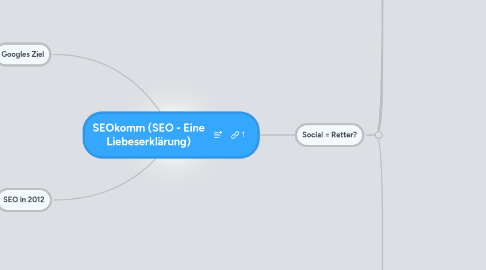
1. Googles Ziel
1.1. Google optimiert für User
1.2. Nicht für SEOs
1.3. Don't buy links
1.4. Problem
1.4.1. Linkkauf
1.4.1.1. „Don't buy links“
1.5. Problemlösung
1.5.1. Linkverkäufer abstrafen
2. SEO in 2012
2.1. Create High Quality Content
2.1.1. Author Auszeichnen schema.org
2.2. Social
2.3. Linkpyramide
2.3.1. Keyword Research & Targeting
2.3.2. Linkbuilding
2.3.3. Content Quality and Accessibility
2.3.4. Social
3. Social = Retter?
3.1. Aktueller Content
3.2. Freiwilliges sharen
3.3. Suchmaschinen müssen darauf reagieren
3.4. Mehr Zeit auf Social Networks als auf Portalen
3.5. Beispiel: Tsunami
3.6. Social Mentions nur ein Trigger für aktuelle Suchergebnisse?
3.6.1. Patent von Yahoo
3.6.1.1. „Experiments indicate that approximately 34,6% of the collected network resources are considered to be recency-sensitive“
3.6.2. Google Freshness Update
3.6.2.1. „Often times when there's breaking news, microblogs are the first to publish. We're able to show results for recent events or hot topics within minutes of the page being indexed, but we're always looking for ways we can serve you relevant information faster and will work to continue improving“
3.6.2.2. Tipp: Patent von Matt Cutts
3.6.2.3. Zwei unterschiedliche Typs:
3.6.2.3.1. Relevante Inhalte
3.6.2.3.2. Aktuelle Inhalte
3.6.2.4. Rankingfaktoren
3.6.2.4.1. Aktuelität
3.6.2.4.2. Linkscore
3.6.2.5. betrifft ca. 35%
3.6.3. Zählen frische Links mehr als alte Links?
3.6.3.1. Überlegung
3.6.3.1.1. Ja klar, macht Sinn
3.6.3.2. Zeitpunkt des Crawlens entscheidet ob fresh oder nicht
3.6.3.3. Links auf alten Content einfügen
3.6.3.3.1. Indikator das SEO am Werk ist
3.6.3.4. Exact Match Anchor Textlinks sind tot
3.6.3.4.1. sofern die Ratio zu hoch ist
3.6.3.4.2. bezogen auf normale Seiten
3.6.3.4.3. Brands können sich mehr erlauben
3.6.3.4.4. Langsam schlechtere Rankings
3.6.3.4.5. Google braucht keinen Anchortext um Inhalt zu erkennen
3.6.3.4.6. „phrased based indexing“
3.7. Ranken Seiten mit guter Social Visibility besser?
3.7.1. Besseres Ranking
3.7.1.1. durch Shares
3.7.1.1.1. Facebook relevant
3.7.1.1.2. Twitter wenig relevant
3.7.1.2. als Links
3.7.2. Correlation is not Causation
3.7.3. Social Mentions = neue Links?
3.7.4. Hälfte im Web nicht im Social Web
3.7.4.1. Gesundheit-, Finanzthemen etc. social schwer zugänglich
3.7.4.2. Beispiel: Hämorrhoiden
3.7.5. Wichtig: Diversity
3.7.5.1. Anzahl uniquer Quellen
3.7.6. Interaction
3.7.6.1. Qualität
3.7.6.2. Quantität
3.7.6.3. von
3.7.6.3.1. Retweets
3.7.6.3.2. Shares
3.7.6.3.3. Clicks
3.7.7. Trust
3.7.7.1. Author Authority
3.7.8. Social Spam
3.7.8.1. Einfach identifizierbar
3.7.8.2. Schwer realen Menschen zu simulieren
3.7.9. Credential Scoring
3.7.9.1. Authority Score
3.7.9.2. Contributiveness Score
3.7.9.3. Domain Authority vs. Author Authority
3.7.10. Interessant
3.7.10.1. Link von Spammy Seite
3.7.10.2. gut wenn Author hohe Authority hat
3.7.11. Paid Authority Authors = new Paid Linkbuilding?
